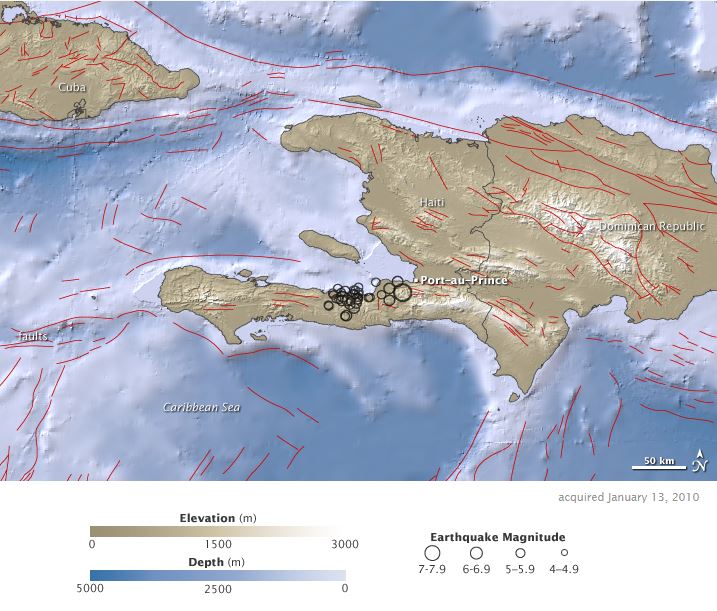Eight years After the Haiti Earthquake, Progress and Challenges

Courtesy of NASA Earth Observations
By Anne Sheehan, AGU Seismology Section President-Elect, Professor of Geological Sciences, University of Colorado Boulder, and Fellow, Cooperative Institute for Research in the Environmental Sciences, University of Colorado Boulder
Eight years ago, on January 12, 2010, a magnitude 7.0 earthquake devastated the city of Port-au-Prince, Haiti, resulting in over 220,000 fatalities (Source: Munich Re) and displacing hundreds of thousands more. The earthquake occurred as the result of shallow strike-slip faulting on the Caribbean-North American plate boundary. The magnitude 7.6 Honduras earthquake earlier this week (January 10, 2018), which thankfully had no casualties, was also along the Caribbean-North American plate boundary. These two earthquakes demonstrate that the correspondence between earthquake size and severity can depend strongly on proximity to densely populated areas with vulnerable infrastructure. The Haiti earthquake is a clear outlier in fatalities for its magnitude.
Earlier this week I talked with Dr. Brian Tucker and Dr. Janise Rodgers from GeoHazards International (GHI, www.geohaz.org ) to learn more about earthquake resilience efforts in Haiti. Because GHI works in preparedness and mitigation rather than response and recovery, they work in parts of Haiti that may experience the next major earthquake: places with high seismic hazard that have not had an earthquake recently. With Dr. Eric Calais, professor at Ecole Normale Superieure, following the 2010 earthquake, GHI designed a project to reduce the earthquake and tsunami risk of the northern coast of Haiti, near an active off-shore fault that last ruptured in 1842. Under the resulting United Nations Development Programme’s (UNDP) Plan Nord, GHI trained construction workers such as masons and material suppliers in earthquake-resistant design and construction techniques. Plan Nord also included the Bureau de Recherches Géologiques et Minières of France, which performed microzonation studies in some of Haiti’s cities. A more recent, USAID-supported GHI project is based in Anse-a-Veau, Haiti, a community on a western segment of the same fault system that devastated Port-au-Prince. The project in Anse-a-Veau supports community-based efforts to provide advice to the public on how to prepare for earthquakes and behave during shaking. GHI is now proposing a project in partnership with Bechtel’s “Building Resilient Communities Initiative” to address tsunami risk on the northern coast of Haiti through the construction of elevated parks that would offer readily accessible refuge at times of flooding and tsunamis, and public recreation in other times. Many of these GHI projects resulted from informal discussions at AGU Fall Meetings, showing the benefit of networking at scientific conferences.
Professor Eric Calais, from Ecole Normale Supérieure in Paris, was kind enough to email me from Haiti today to update me on some of the progress and ongoing challenges regarding earthquake reconstruction and preparedness in Haiti. Calais served a science advisor to the United National Disaster Risk Reduction Program in Haiti after the 2010 earthquake, and has continued leadership in earthquake safety and building scientific capacity within Haiti since that time. Some of the positives pointed out by Calais include publication of a national seismic hazard map, development of a national building code, several new buildings designed and built according to the seismic code (notably the new administrative quarter of Port-au-Prince), training of construction professionals, development of an operational seismic network, several Haitian PhD students trained abroad and now working in Haiti, and a new masters program at the State University of Haiti in geosciences-geohazards. Challenges that remain include the difficulty in finding funding to update the seismic hazard map despite much new data, difficulty in finding funding to operate and maintain the seismic network, the lack of a legal framework to impose earthquake safe construction, and the difficulty of doing anything for the informal construction (non-engineered) which represents up to 90% of the buildings in Haiti (this is common in many countries exposed to earthquake hazard). Calais emphasized the importance of training in-country professionals, and finds hope in the efforts being made by the State University of Haiti to initiate the masters program mentioned above that is now training the next generation of risk-reduction specialists in Haiti.
Throughout the broader Caribbean region, several efforts have enhanced earthquake and tsunami monitoring since the 2010 Haiti earthquake. The Continuously Operating Caribbean GPS Observational Network (COCONet) in Caribbean and Caribbean-border nations is a geodetic network operated by UNAVCO, with support from the U.S. National Science Foundation and partners from many other countries and now provides real time geodetic data for studies of plate kinematics, the earthquake cycle, volcanic processes and even hurricane tracking. The United Nations Educational, Scientific and Cultural Organization (UNESCO) Intergovernmental Coordinating Group (ICG) for the Tsunami and other Coastal Hazards Early Warning System for the Caribbean and Adjacent Regions (CARIBE-EWS) has developed performance standards for detection and analysis of earthquakes, and now over 100 seismic stations, from nearly every nation in the Caribbean region, contribute real-time data to tsunami warning centers (McNamara et al., 2016). These projects provide data essential for understanding the processes leading to major earthquakes and tsunamis.
The 2018 report of the United Nations Office for the Coordination of Humanitarian Affairs (OCHA) reports that 1.9 million Haitians are still in need of aid, and that continued investment in preparedness and disaster risk reduction is required (this includes hurricanes in addition to earthquakes). The 2010 Haiti earthquake is a clear example of the risk brought about by increasing exposure of vulnerable populations to hazards – and a future where dire outcomes affecting local to global populations may occur unless such vulnerabilities are reduced through education, science, technology, informed policy and global cooperation.




we thank you for work Ms Anne Sheehan, we also thank your team for the great job
Curious, about the progress if any. Are people still waiting for help to rebuild or do they have the new buildings and housing after seven long years.?